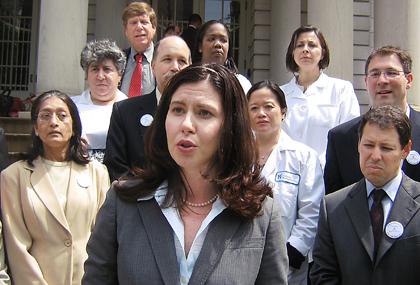By Jeremy Walsh
Queens’ health care system, already hit hard by the recent closures of three hospitals, is facing another painful blow as a looming increase in malpractice insurance rates threatens to slash the ranks of medical professionals who deliver babies.
Speaking with a group of doctors on the steps of City Hall, City Councilwoman Elizabeth Crowley (D-Middle Village) announced a petition drive to persuade Gov. David Paterson not to increase the malpractice insurance rates starting next month and to establish an affordable public insurance option for doctors paying as much as $163,000 for liability protection in Queens.
A state moratorium on increasing malpractice insurance rates, established by former Gov. Eliot Spitzer in 2007, is slated to expire July 1.
“Who will deliver babies in New York Cityi” Crowley said, warning that 28 obstetricians serving the five boroughs would give up the medical specialty next month if Paterson does not intervene. The New York branch of the American College of Obstetricians and Gynecologists did not have information on how many of those doctors serve Queens.
Obstetricians in New York face far more malpractice claims than much of the country, according to the ACOG, whose 2006 survey found that 44 percent of the specialists in the state had faced four or more malpractice claims during their career, compared with the national average of 29.5 percent.
“You have to think of us as small business owners,” said Dr. Lisa Ng. “Doctors pay rent. We pay the utilities. We pay our employees. Then we have to fight the HMOs to get paid.”
Jay Tartell, a radiologist with Mt. Sinai Hospital in Astoria, said malpractice rates are high for other areas of women’s health as well, which creates staff shortages as doctors seek less risky niches. Mt. Sinai has been looking for a mammographer for 17 months, creating wait times as long as one year for the breast scans.
“If premiums go up further in July, we may be forced to eliminate women’s imaging altogether,” he said.
Dr. Mitch Essig, who has been an obstetrician for 28 years, said his malpractice insurance premiums were $8,000 a year in 1981. Now they are $155,000, he said, noting he is giving up that specialty in July.
But the issue is complicated by the fragile state of the insurance companies. Physicians’ Reciprocal Insurers, which insures nearly one-fourth of the state’s physicians, filed an annual report last month with the state Insurance Department, showing a deficit of more than $43 million. The insolvency of the company could leave it unable to pay malpractice claims.
Some reports blamed the company’s dire straits on the two-year rate freeze. It had requested a 30 percent rate hike in 2006, but the state approved a 14 percent increase.
Reach reporter Jeremy Walsh by e-mail at jewalsh@cnglocal.com or by phone at 718-229-0300, Ext. 154.
































